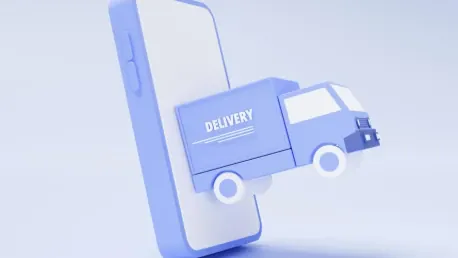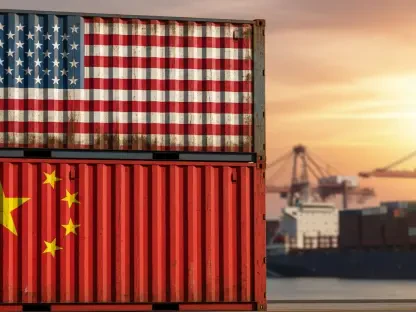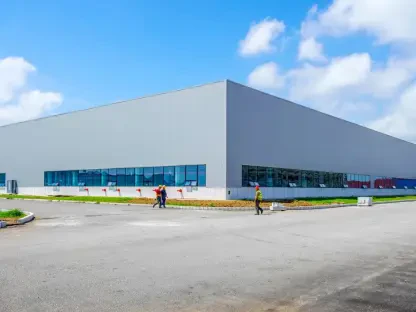The post-holiday season often brings a noticeable dip in consumer spending as people tighten their belts after the festive splurge. However, this period also presents a unique opportunity for businesses to leverage last-mile delivery services to maintain momentum and even stimulate growth. By focusing on efficient and reliable delivery solutions, businesses can meet consumer demands for convenience and speed, ensuring customer loyalty and a competitive edge.
Understanding the Post-Holiday Slowdown
The Impact of the Golden Quarter
The last quarter of the year, often referred to as the ‘Golden Quarter,’ is a critical revenue period for many businesses, particularly in retail and grocery sectors. During this time, consumer spending peaks, driven by holiday shopping and festive preparations. However, once the holidays are over, there is a significant drop in spending as consumers look to cut costs and recover from their holiday expenses. This sudden decline can create a challenging environment for businesses that rely heavily on the surge in end-of-year sales. Maintaining profitability during this off-peak period demands innovative strategies to engage customers and sustain revenue streams.
In contrast to the high sales during the Golden Quarter, January tends to witness a more cautious approach to spending. Consumers, having indulged in festive exuberance, often face financial constraints and adopt austerity measures. Despite reduced activity in physical stores, this period presents an avenue for businesses to focus on enhancing their delivery capabilities. By recognizing the shift in consumer behavior and adjusting their strategies accordingly, businesses can turn potential slowdowns into opportunities for continued engagement. The ability to cater to at-home convenience becomes a vital factor in retaining customer loyalty when foot traffic diminishes.
Consumer Behavior in January
Despite the overall decline in spending, January presents unique opportunities for businesses. Colder weather and the desire for convenience drive an increase in demand for home delivery services. Consumers prefer to stay indoors and avoid the hassle of going out in adverse weather conditions, making last-mile delivery an attractive option. This shift in consumer preferences toward home delivery creates a window for businesses to capitalize on. By emphasizing the ease and comfort of having products brought directly to their doorstep, companies can address the needs of customers who are inclined to minimize outdoor activities during winter months.
Understanding these behavioral patterns allows businesses to tailor their marketing and operational strategies to meet consumer expectations. By providing timely and efficient delivery services, companies can maintain engagement with their customer base and encourage repeat purchases. The challenge lies in ensuring that the delivery infrastructure is robust enough to handle increased demand while maintaining service quality. For businesses, adapting to these seasonal changes in consumer behavior can lead to sustained growth and a competitive advantage. Leveraging last-mile delivery services during the post-holiday slowdown requires a focus on reliability and customer satisfaction.
Strategic Importance of Last-Mile Delivery
Beyond Logistics: A Strategic Differentiator
Last-mile delivery services are not just about logistics; they are strategic differentiators that can help businesses expand their reach and tap into new revenue streams. By offering fast and efficient delivery, businesses can attract and retain customers who value convenience and reliability. This approach allows businesses to maintain competitive pricing without compromising profit margins. For many consumers, the ability to receive products quickly and without hassle is a significant factor in their purchasing decisions. Therefore, investing in high-quality delivery services can set a business apart from its competitors.
The strategic importance of last-mile delivery extends beyond mere operational efficiency. It encompasses building a brand reputation that resonates with consumers’ expectations for speed and convenience. In an increasingly competitive market, businesses that prioritize last-mile delivery can position themselves as leaders in customer satisfaction. This can lead to enhanced brand loyalty and positive word-of-mouth, ultimately driving long-term profitability. Moreover, efficient delivery systems can facilitate market expansion by reaching customers in previously underserved areas. Thus, last-mile delivery becomes a pivotal component of a comprehensive business strategy aimed at growth and sustainability.
Overcoming Delivery Challenges
Entering the delivery market comes with its own set of challenges, including the need for investment in hiring, training, technology, and infrastructure. However, partnering with established delivery services can help businesses bypass these hurdles. Companies like Stuart provide ready platforms and trained couriers, ensuring operational efficiency and ease of implementation. For many businesses, the logistical and financial barriers associated with developing in-house delivery capabilities can be daunting. Collaborating with experienced service providers allows companies to leverage existing expertise and infrastructure, avoiding the steep learning curve.
Furthermore, these partnerships offer flexibility and scalability that are crucial for adapting to fluctuating customer demands. Businesses can benefit from the extensive networks and resources that established delivery services offer, ensuring consistent service quality. By outsourcing delivery logistics, companies can focus on their core competencies while maintaining a high standard of customer service. This approach not only streamlines operations but also reduces the risk associated with managing a delivery fleet. Consequently, businesses can achieve a smoother transition into offering last-mile delivery services, ultimately benefiting from increased customer satisfaction and retention.
Advantages of White-Label Delivery Services
Maintaining Brand Loyalty
White-label delivery services offer a significant advantage over aggregators by allowing businesses to maintain control over customer interactions and experiences. This direct interaction ensures that any delivery issues do not erode the trust and loyalty customers have for the brand itself. By keeping the delivery process under their own brand, businesses can strengthen customer relationships and enhance brand loyalty. When customers receive their orders through a white-label service, they perceive the entire transaction as a cohesive brand experience rather than as an external service.
Maintaining this level of control over the delivery process is crucial for preserving the integrity of the brand. Customers are more likely to remain loyal when they have a seamless and consistent experience from browsing to delivery. White-label services enable businesses to address issues promptly and maintain transparency with their customers, fostering a sense of reliability and responsiveness. In contrast, relying on aggregators can dilute the brand identity and lead to fragmented customer experiences. Therefore, white-label delivery services help businesses uphold their brand values and provide a superior level of service that encourages repeat business.
Enhancing Customer Experience
White-label services enable businesses to provide a seamless and consistent customer experience. From placing an order to receiving the delivery, customers interact directly with the brand, which helps in building a stronger connection and trust. This approach not only improves customer satisfaction but also encourages repeat business and positive word-of-mouth referrals. By managing the delivery process internally, businesses can ensure that customers receive the same level of service excellence they expect from other aspects of the brand.
Moreover, the ability to customize the delivery experience according to brand standards allows businesses to differentiate themselves in a crowded market. Tailoring the delivery process to meet specific customer preferences and needs enhances overall satisfaction and builds long-term loyalty. In essence, white-label services provide businesses with the tools to create a cohesive and unified brand experience that extends beyond the point of sale. This comprehensive approach to customer engagement can lead to increased brand advocacy and a competitive edge. Fostering strong relationships through reliable and branded delivery services is essential for sustaining growth and maintaining a loyal customer base.
Successful Implementations and Evidence
Case Studies: Tesco, Coop, and Aesop
Stuart’s collaboration with well-known brands such as Tesco, Coop, and Aesop showcases the successful implementation of tailored delivery solutions. These partnerships have significantly enhanced operational efficiency and profitability for the businesses involved. By integrating Stuart’s delivery services, these brands have been able to meet consumer demands for fast and reliable delivery, resulting in increased customer satisfaction and loyalty. The success of these case studies underscores the effectiveness of partnering with established delivery platforms in achieving business goals.
For instance, Tesco’s ability to maintain service excellence during peak periods and beyond has been bolstered by its partnership with Stuart. This collaboration has enabled Tesco to streamline its delivery operations, ensuring timely and accurate deliveries. Similarly, Coop and Aesop have benefited from improved logistics and customer engagement through tailored delivery solutions. These examples highlight how leveraging the expertise of specialized delivery services can lead to tangible improvements in operational performance and customer relationship management. The positive outcomes from these collaborations serve as evidence of the strategic value of integrating last-mile delivery services.
Integration with Platforms like Slerp
The integration of delivery services with platforms like Slerp further demonstrates the positive impact on business metrics. Efficient delivery solutions have led to substantial delivery volumes, showcasing the potential for growth and profitability. Businesses that have adopted these integrated delivery services have seen improvements in their overall operations and customer engagement. By utilizing platforms such as Slerp, companies can offer a seamless ordering and delivery experience that meets the high expectations of their customers.
This integration allows businesses to capitalize on the technological capabilities of established platforms, ensuring a smooth and efficient delivery process. The resulting increase in delivery volumes reflects the heightened demand for reliable and convenient services. Companies that successfully incorporate these solutions into their operations often experience enhanced customer satisfaction and repeat patronage. Slerp’s platform, coupled with effective delivery services, exemplifies how strategic partnerships can drive business performance and foster long-term success. Ultimately, these implementations highlight the importance of aligning technological advancements with consumer preferences to remain competitive.
Navigating the Challenges of Delivery Infrastructure
Investment and Operational Hurdles
Building an in-house delivery fleet requires significant investment in terms of hiring, training, technology, and infrastructure. These operational hurdles can be daunting for many businesses, especially smaller ones. However, partnering with established delivery services like Stuart can help mitigate these challenges by providing ready-to-use platforms and trained couriers. For companies looking to expand their delivery capabilities without incurring substantial upfront costs, collaboration with experienced delivery providers offers a viable solution.
This approach allows businesses to circumvent the complexities associated with developing and managing a dedicated delivery infrastructure. By leveraging the resources and expertise of established services, companies can ensure a high standard of delivery while focusing on their core business functions. The operational efficiency gained through such partnerships can lead to improved service quality and customer satisfaction. For smaller businesses, in particular, the ability to offer competitive delivery services without significant investment can be a game-changer. Streamlining delivery operations through partnerships can result in enhanced profitability and market reach.
Benefits of Partnering with Established Services
By collaborating with established delivery services, businesses can focus on their core operations while leveraging the expertise and infrastructure of their delivery partners. This approach not only improves efficiency but also ensures that businesses can meet consumer demands for fast and reliable delivery without the need for substantial upfront investment. Established delivery services bring industry know-how and scalable solutions that are critical for maintaining service quality during periods of fluctuating demand.
Moreover, these partnerships provide businesses with access to advanced logistics technology and analytics, enabling better decision-making and operational planning. The ability to rely on the infrastructure of specialized delivery providers allows companies to offer superior delivery experiences to their customers. This synergy between businesses and delivery partners fosters a collaborative environment where both parties benefit from shared success. Ultimately, the strategic use of established delivery services can drive business growth by enhancing operational efficiency and customer satisfaction. The benefits of such collaborations are evident in the improved performance and competitive advantage they provide.
Conclusion
After the holiday season, consumer spending typically declines as people tighten their finances following their festive spending spree. Despite this predictable trend, the post-holiday period offers businesses a strategic opportunity to utilize last-mile delivery services to not only sustain their momentum but also potentially stimulate growth. By prioritizing efficient and reliable delivery solutions, businesses can cater to the increasing consumer demand for convenience and speed. This focus on swift and dependable delivery not only satisfies consumer expectations but also helps in fostering customer loyalty, which is crucial for long-term success. Businesses that succeed in providing seamless delivery experiences can achieve a competitive edge, standing out in a crowded market. Through investment in advanced logistics and innovative delivery options, companies can enhance their service offerings, ensuring customers receive their purchases quickly and efficiently. This can mitigate the usual post-holiday sales slump and even drive continuous engagement and revenue as customers remain satisfied and inclined to return for future purchases.








